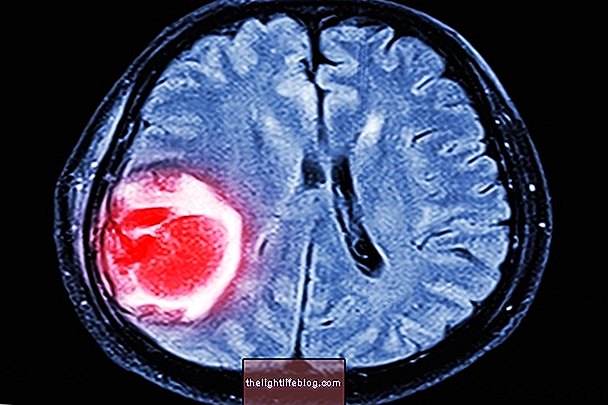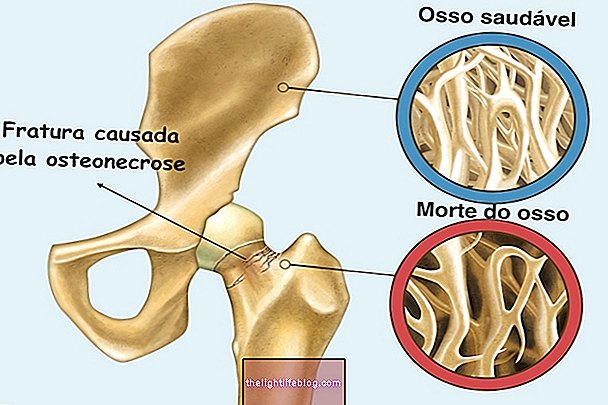Tumor in the liver is characterized by the presence of a mass in this organ, but this is not always a sign of cancer. Masses in the liver are relatively common in men and women and may mean hemangioma or hepatocellular adenoma, which are benign tumors. However, although they are not cancer they can cause liver enlargement or hepatic bleeding.
The treatment depends on the symptoms presented by the person and the severity of the tumor, and the doctor can only indicate the evolution of the tumor and the symptoms or surgery to remove the tumor or part of the liver. The tumor in the liver is cured if it is identified early and treated according to medical advice.

What may be liver tumor
Tumors in the liver can be benign or malignant. The benign ones do not spread to another region of the body, they do not pose risk to the health and can be:
- Hemangioma: is the most common benign liver tumor and corresponds to a small nodule formed by a tangle of blood vessels that do not cause symptoms. Know what the hemangioma is and when it can be serious.
- Focal nodular hyperplasia: the cause of this benign tumor is not well understood, however it may be related to changes in blood flow.
- Hepatic adenoma: it is more common in women between 20 and 50 years and is most often caused by prolonged use of oral contraceptives. See how the diagnosis of hepatic adenoma is made and possible complications.
Malignant tumors cause symptoms and are most often the result of metastasis from bowel cancer, for example. The main malignant tumors of the liver are:
- Hepatocellular carcinoma or hepatocarcinoma: it is the most common type of primary cancer of the liver, is more aggressive and has origin in the cells that form the liver, hepatocytes;
- Angiosarcoma of the liver: is the tumor of cells lining the wall of blood vessels present in the liver and happens due to exposure to toxic substances, such as vinyl chloride;
- Cholangiocarcinoma: a type of tumor that originates in the bile ducts and usually occurs in people between 60 and 70 years;
- Hepatoblastoma: is a rare type of liver tumor, usually occurs in children under 3 years and stimulates the production of hormone (hCG), which accelerates the process of puberty, inducing precocious puberty.
People who have liver fat, have liver cirrhosis or use anabolic drugs are at a higher risk of developing a malignant liver tumor. Learn to identify signs of liver cancer.
Signs and symptoms of liver tumor
Benign liver tumors usually do not cause symptoms and are usually only discovered on a routine examination. Already the malignant present some symptoms like:
- Presence of abdominal mass;
- Abdominal pain or discomfort;
- Bleeding in the liver;
- Weight loss;
- Swollen belly;
- Malaise;
- Skin and yellow eyes.
Once the symptoms are identified, the general practitioner or hepatologist may request some diagnostic imaging tests, such as ultrasonography, computed tomography or magnetic resonance imaging to confirm the diagnosis. In some cases it may be necessary to perform a biopsy to make the diagnosis.
In the case of benign tumors, these tests are usually required to look for any other condition that is not related to the liver. Blood tests most often do not indicate the occurrence of these types of tumors, since liver functions usually remain normal or discreetly elevated.
How is the treatment done?
Treatment for liver tumor depends on many factors, but may include exposure to radiation and sometimes surgery may be necessary to remove the tumor or the diseased part of the liver. The use of drugs for liver tumors is often not indicated as part of the drug's metabolism process is performed in the liver and when this organ is compromised there may be no correct metabolism of the drug or it may cause further damage to the organ. It is important to seek guidance from the general practitioner or hepatologist for more accurate guidance regarding treatment.
Tumor Surgery in the Liver
Tumor surgery in the liver requires general anesthesia and the subject should remain in the hospital for a few days or weeks. Depending on the type of tumor and its severity the doctor may choose not to perform the surgery.
In some cases, the doctor may choose not to move either the tumor or the liver, but observe the progression of the tumor and decide to undergo surgical intervention when the tumor can compromise the functioning of the organ. Thus, the physician may choose to remove the tumor or part of the liver to resolve the patient's clinical condition.
Does liver tumor have a cure?
The tumor in the liver can be cured when the disease is discovered early and is properly treated. The indication of radiation therapy, chemotherapy or surgery will depend on the state of the tumor, whether it is advanced or not and the general health of the person.






















